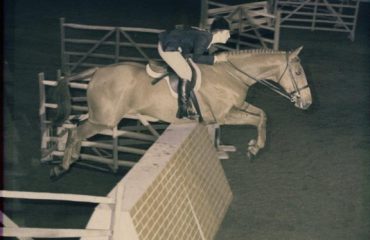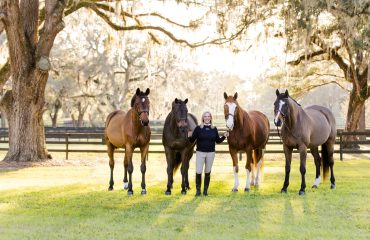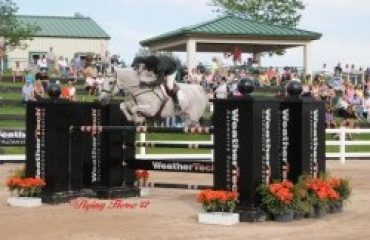
Shannon Peters
Photo by Lahorstman Photography
Shannon Peters is a U.S. Dressage Federation bronze, silver and gold medalist, and three-time National Championship competitor. She loves bringing young horses up through the levels, and competes regularly both in Southern California CDIs and other top shows. Shannon is married to Olympic dressage rider Steffen Peters, and together they operate Arroyo Del Mar in San Diego, California. Do you have a question you want Shannon to answer? Send questions to editor@sidelinesnews.com.
What particular qualities do you look for in a young dressage horse prospect?
Character and rideability go a long way! And of course, #1 on the training scale is rhythm. A young prospect must have three good, rhythmic basic paces and a true desire to go forward in all three paces, with natural self-carriage. We also look for good conformation — strong hindquarters, nice uphill shoulders and a neck that’s set on well. Conformational faults are not a deal breaker, and many things can be improved upon with proper training and gymnastics, but it’s always better to start with the best possible foundation.
What tips do you have for memorizing tests?
Try to memorize by section. For instance, memorize from your entrance, and halt at X. For sure know which way you turn! From that point, memorize the trot pattern up until the walk. Ride this pattern a couple of times until it flows easily. On another day of the week, start from the walk pattern, proceed into the canter and finish the test until the final salute. Repeat a couple of times until it flows smoothly. In preparation for a show, I usually have my students ride the entire test on Fridays. As a general rule of thumb, always know which way you turn in the beginning of your test, and know where you walk.
Do you use off-the-horse exercises to help with your riding, and if so, what do you do?
Yes! I cross-train twice per week in the gym to help strengthen the muscles that aren’t developed from just riding, and lengthen and stretch the muscles that we overuse in riding. An imbalance in these muscles usually leads to pain and injury. I also play tennis, which keeps me competitively sharp even in the off season, and something mentally stimulating off the horse. I also ride road/mountain bikes, which is a fabulous time for me spent in nature — no phones, texts, emails … just the open road.
How would you suggest organizing practice time for the best overall progress?
I tell my students to always have a plan! As you’re grooming your horse and preparing for your ride, go over the things in your mind that you’d like to improve upon from the prior week or day. Try not to tackle too many items at once; it’ll be overwhelming for both you and your horse. My teacher always says, “Keep it simple.” Start with a basic plan, and go back to it often. Test your proficiency and your horse’s responsiveness to the tasks that you planned for the ride before you move on to something else. Also, if you have a very busy work and/or family life, and trying to “squeeze it all in” is hard sometimes, make sure you write things down in a notebook that you keep in your tack box. Being able to sit for a moment, decompress and read what you’ve done and want to accomplish in the recent weeks will help you stay focused on your training plan.













